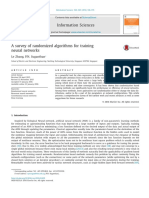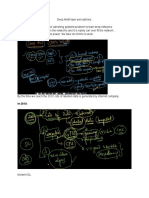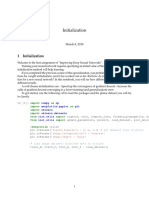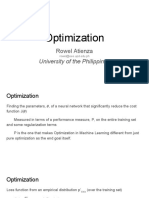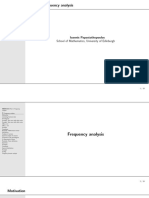Machine Learning and Pattern Recognition Week 8 - Neural - Net - Fitting
Uploaded by
zeliawillscumbergMachine Learning and Pattern Recognition Week 8 - Neural - Net - Fitting
Uploaded by
zeliawillscumbergFitting and initializing neural networks
Neural networks are almost always fitted with gradient based optimizers, such as variants
of Stochastic Gradient Descent1 . We defer how to compute the gradients to the next note.
1 Initialization
How do we set the initial weights before calling an optimizer? Don’t set all the weights to
zero! If different hidden units (adaptable basis functions) start out with the same parameters,
they will all compute the same function of the inputs. Each unit will then get the same
gradient vector, and be updated in the same way. As each hidden unit remains the same, or
neural network function can only depend on a single linear combination of the inputs.
Instead we usually initialize the weights randomly. Don’t simply set all the weights using
randn() though! As a concrete example, if all your inputs were xd ∈√{−1, +1} the activation
(w(k) )> x to hidden unit k would have zero mean, but typical size D if there are D inputs.
(See the review of random walks on the expectations notes.) If your units saturate, like
the logistic sigmoid, most of the gradients will be close to zero, and it will be hard for the
gradient optimizer to update the parameters to useful settings.
Summary: initialize a weight matrix that transforms K values to small random values, like
0.1*randn()/sqrt(K), assuming your input features are ∼1.
The MLP course points to Glorot and Bengio’s (2010) paper Understanding
p the difficulty of
training deep feedforward networks, which suggests a scaling ∝ 1/ K (l ) + K (l −1) , involving
the number of hidden units in the layer after the weights, not just before. The argument
involves the gradient computations, which we haven’t described in detail for neural networks
yet, so we defer the interested reader to the paper or the MLP (2019) slides2 .
Some specialized neural network architectures have particular tricks for initializing them.
Do a literature search if you find yourself trying something other than a standard dense
feedforward network: e.g., recurrent/recursive architectures, convolutional architectures,
transformers, or memory networks. Alternatively, a pragmatic tip: if you are using a neural
network toolbox, try to process your data to have similar properties to the standard datasets
that are usually used to demonstrate that software. For example, similar dimensionality,
means, variances, sparsity (number of non-zero features). Then any initialization tricks that
the demonstrations use are more likely to carry over to your setting.
2 Local optima
The cost function for neural networks is not unimodal, and so is certainly not convex (a
stronger property). We can see why by considering a neural network with two hidden units.
Assume we’ve fitted the network to a (local) optimum of a cost function, so that any small
change in parameters will make the network worse. Then we can find another parameter
vector that will represent exactly the same function, showing that the optimum is only a
local one.
To create the second parameter vector, we simply take all of the parameters associated
with hidden unit one, and replace them with the corresponding parameters associated with
hidden unit two. Then we take all of the parameters associated with hidden unit two and
replace them with the parameters that were associated with hidden unit one. The network is
really the same as before, with the hidden units labelled differently, so will have the same
cost.
1. Adam (https://arxiv.org/abs/1412.6980) has now been popular for some time, although pure SGD is still in
use too.
2. https://www.inf.ed.ac.uk/teaching/courses/mlp/2019-20/lectures/mlp06-enc.pdf
MLPR:w8c Iain Murray and Arno Onken, http://www.inf.ed.ac.uk/teaching/courses/mlpr/2020/ 1
Models with “hidden” or “latent” representations of data, usually have many equivalent
ways to represent the same model. When the goal of a machine learning system is to make
predictions, it doesn’t matter whether the parameters are well-specified. However, it’s worth
remembering that the values of individual parameters are often completely arbitrary, and
can’t be interpreted in isolation.
In practice local optima don’t just correspond to permuting the hidden units. Some local op-
tima will have better cost than others, and some will make predictions that generalize better
than others. For small neural networks, one could fit many times and use the network that
cross-validates the best. However, researchers pushing up against available computational
resources will find it difficult to optimize a network many times.
One advantage of large neural networks is that fitting far more parameters than necessary
tends to work better(!). One intuition is that there are many more ways to set the parameters
to get low cost, so it’s less hard to find one good setting.3 Although it’s difficult to make
rigorous statements on this issue. Understanding the difficulties that are faced in really
high-dimensional optimization is an open area of research. (For example, https://arxiv.
org/abs/1412.6544.)
3 Regularization by early stopping
We have referred to complex models that generalize poorly as “overfitted”. One idea to avoid
“overfitting” is to fit less! That is, stop the optimization routine before it has found a local
optimum of the cost function. This heuristic idea is often called “early stopping”.
The most common way to implement early stopping is to periodically monitor performance
on a validation set. If the validation score is the best that we have seen so far, we save a
copy of the network’s parameters. If the validation score fails to improve upon that cost over
some number of future checks (say 20), we stop the optimization and return the weights
we’ve saved.
David MacKay’s textbook mentions early stopping (Section 39.4, p479). This book points
out that stopping the optimizer prevents the weights from growing too large. Goodfellow
et al.’s deep learning textbook (Chapter 7) makes a more detailed link to L2 regularization.
MacKay argued that adding a regularization term to the cost function to achieve a similar
effect seems more appealing: if we have a well-defined cost function, we’re not tied to a
particular optimizer, and it’s probably easier to analyse what we’re doing.
However, I’ve found it hard to argue with early stopping as a pragmatic, sensible procedure.
The heuristic directly checks whether continuing to fit is improving predictions for held-out
data, which is what we care about. And we might save a lot of computer time by stopping
early. Moreover, we can still use a regularized cost function along with early stopping.
Questions: These questions don’t relate to early stopping, but seemed natural to ask after
the video above, which had some more general review:
• [The website version of this note has a question here.]
• [The website version of this note has a question here.]
4 Regularization corrupting the data or model
There are a whole family of methods for regularizing models that involve adding noise to
the data or model during training. As with early-stopping, it can be hard to understand
what objective we are fitting, and the effect of the regularizer can depend on which optimizer
we are using. However, these methods are often effective. . .
3. The high-level idea is old, but a recent (2018) analysis described the idea that some parts of a large network
“get lucky” and identify good features as “The Lottery Ticket Hypothesis”, https://arxiv.org/abs/1803.03635
MLPR:w8c Iain Murray and Arno Onken, http://www.inf.ed.ac.uk/teaching/courses/mlpr/2020/ 2
Adding Gaussian noise to the inputs of a linear model during gradient training has the
same average effect as L2 regularization4 . We can also add noise when training neural
networks. The procedure will still have a regularization effect, but one that’s harder to
understand. We can also add noise to the weights or hidden units of a neural network.
In some applications, adding noise has worked better than optimizing easy-to-define cost
functions (like L2 regularizers).
Other regularization methods randomly replace some of the weights with zeros (“drop-
out”5 ) or features with zeros (such as in “denoising auto-encoders”6 or a 2006 feature-
dropping regularizer). These heuristics prevent the model from fitting delicate combinations
of parameters, or fits that depend on careful combinations of features. If used aggressively,
“masking noise” makes it hard to fit anything! Often large models are needed when using
these heuristics.
5 Further Reading
Most textbooks are long out-of-date when it comes to recent practical wisdom on fitting
neural networks and regularization strategies. However, https://www.deeplearningbook.
org/ is still fairly recent, and is a good starting point. The MLP notes are also more detailed
on practical tips for deep nets.
If you were to read about one more trick, perhaps it should be Batch Normalization (or “batch
norm”), which is (just) “old” enough to be covered in the deep learning textbook. Like most
ideas, it doesn’t always improve things, so experiments are required. And variants are still
being actively explored.
The discussion in this note about initialization pointed out that we don’t want to saturate
hidden units. Batch normalization shifts and scales the activations for a unit across a training
batch to have a target mean and variance. Gradient-based training of the neural nets often
then works better. In hindsight it’s surprising amazed that this trick is so recent: it’s a simple
idea that someone could have come up with in a previous decade, but didn’t.
4. Non-examinable: there’s a sketch in these slides: https://www.cs.toronto.edu/~tijmen/csc321/slides/
lecture_slides_lec9.pdf. More detail in Bishop’s (1995) neural network textbook, section 9.3.
5. https://www.cs.toronto.edu/~hinton/absps/JMLRdropout.pdf
6. http://icml2008.cs.helsinki.fi/papers/592.pdf
MLPR:w8c Iain Murray and Arno Onken, http://www.inf.ed.ac.uk/teaching/courses/mlpr/2020/ 3
You might also like
- Machine Learning with Clustering: A Visual Guide for Beginners with Examples in PythonFrom EverandMachine Learning with Clustering: A Visual Guide for Beginners with Examples in PythonNo ratings yet
- Information Sciences: Le Zhang, P.N. SuganthanNo ratings yetInformation Sciences: Le Zhang, P.N. Suganthan3 pages
- 1. Introduction to deep learning- Deep feed forward networkNo ratings yet1. Introduction to deep learning- Deep feed forward network24 pages
- Neural Networks For Machine Learning: Lecture 9a Overview of Ways To Improve GeneralizationNo ratings yetNeural Networks For Machine Learning: Lecture 9a Overview of Ways To Improve Generalization39 pages
- A Survey of Randomized Algorithms For Training Neural NetworksNo ratings yetA Survey of Randomized Algorithms For Training Neural Networks10 pages
- Towards A Mathematical Understanding of Neural Network-Based Machine Learning: What We Know and What We Don'tNo ratings yetTowards A Mathematical Understanding of Neural Network-Based Machine Learning: What We Know and What We Don't56 pages
- Chap 2 Training Feed Forward Neural NetworksNo ratings yetChap 2 Training Feed Forward Neural Networks22 pages
- Initializing Neural Networks - Deeplearning - AiNo ratings yetInitializing Neural Networks - Deeplearning - Ai15 pages
- Deep Neural Network Module 4 RegularizationNo ratings yetDeep Neural Network Module 4 Regularization53 pages
- week 03-04 - Deep Feedforward Networks - IntroNo ratings yetweek 03-04 - Deep Feedforward Networks - Intro141 pages
- CS 224D: Deep Learning For NLP: Lecture Notes: Part III Spring 2015No ratings yetCS 224D: Deep Learning For NLP: Lecture Notes: Part III Spring 201514 pages
- U O D L J M L C: Nderstanding Ptimization of EEP Earning Via Acobian Atrix and Ipschitz OnstantNo ratings yetU O D L J M L C: Nderstanding Ptimization of EEP Earning Via Acobian Atrix and Ipschitz Onstant48 pages
- Fixing Neural Network Course 2 1659759284No ratings yetFixing Neural Network Course 2 165975928430 pages
- Sigmoid Neural Networks to Predict Handwritten DigitsNo ratings yetSigmoid Neural Networks to Predict Handwritten Digits16 pages
- CS 224D: Deep Learning For NLP: Lecture Notes: Part III Spring 2016No ratings yetCS 224D: Deep Learning For NLP: Lecture Notes: Part III Spring 201614 pages
- Deep Learning Basics (Lecture Notes) : Romain TavenardNo ratings yetDeep Learning Basics (Lecture Notes) : Romain Tavenard49 pages
- Deep Learning Meets Sparse Regularization: A Signal Processing PerspectiveNo ratings yetDeep Learning Meets Sparse Regularization: A Signal Processing Perspective23 pages
- Deep Learning With Python Illustrated Guide For Beginners & Intermediates: The Future Is Here!: The Future Is Here!, #2From EverandDeep Learning With Python Illustrated Guide For Beginners & Intermediates: The Future Is Here!: The Future Is Here!, #21/5 (1)
- MLPR w0f - Machine Learning and Pattern RecognitionNo ratings yetMLPR w0f - Machine Learning and Pattern Recognition3 pages
- Machine Learning and Pattern Recognition Minimal Stochastic Variational Inference DemoNo ratings yetMachine Learning and Pattern Recognition Minimal Stochastic Variational Inference Demo3 pages
- Machine Learning and Pattern Recognition - Laplace - ApproximationNo ratings yetMachine Learning and Pattern Recognition - Laplace - Approximation4 pages
- Machine Learning and Pattern Recognition Variational KLNo ratings yetMachine Learning and Pattern Recognition Variational KL5 pages
- Machine Learning and Pattern Recognition Sampling Based ApproximationsNo ratings yetMachine Learning and Pattern Recognition Sampling Based Approximations3 pages
- Chap 5-1 - Machine Learning Basics - Jinwook KimNo ratings yetChap 5-1 - Machine Learning Basics - Jinwook Kim39 pages
- Data Science Interview Questions With Answers ?No ratings yetData Science Interview Questions With Answers ?16 pages
- The Secret Sharer: Evaluating and Testing Unintended Memorization in Neural NetworksNo ratings yetThe Secret Sharer: Evaluating and Testing Unintended Memorization in Neural Networks19 pages
- Epolar-Unet: An Edge-Attending Polar Unet For Automatic Medical Image Segmentation With Small DatasetsNo ratings yetEpolar-Unet: An Edge-Attending Polar Unet For Automatic Medical Image Segmentation With Small Datasets12 pages
- Flock Safety Technologies in Law Enforcement: An Initial Evaluation of Effectiveness in Aiding Police in Real-World Crime Clearance100% (1)Flock Safety Technologies in Law Enforcement: An Initial Evaluation of Effectiveness in Aiding Police in Real-World Crime Clearance22 pages
- Machine Learning Based Hyperspectral Image Analysis: A SurveyNo ratings yetMachine Learning Based Hyperspectral Image Analysis: A Survey46 pages
- The Problem of Overfitting: PerspectiveNo ratings yetThe Problem of Overfitting: Perspective12 pages
- 2.b Applied Machine Learning Secret Sauce - SlidesNo ratings yet2.b Applied Machine Learning Secret Sauce - Slides41 pages
- Complete Guide To Parameter Tuning in XGBoost (With Codes in Python) PDFNo ratings yetComplete Guide To Parameter Tuning in XGBoost (With Codes in Python) PDF20 pages
- Self-Study Plan For Becoming A Quantitative Trader - Part IINo ratings yetSelf-Study Plan For Becoming A Quantitative Trader - Part II4 pages
- Top 45 Machine Learning Interview Questions in 2025No ratings yetTop 45 Machine Learning Interview Questions in 202537 pages
- Machine Learning with Spark and Python Essential Techniques for Predictive Analytics 2nd Edition Michael Bowles - Download the ebook today and own the complete content100% (2)Machine Learning with Spark and Python Essential Techniques for Predictive Analytics 2nd Edition Michael Bowles - Download the ebook today and own the complete content47 pages








